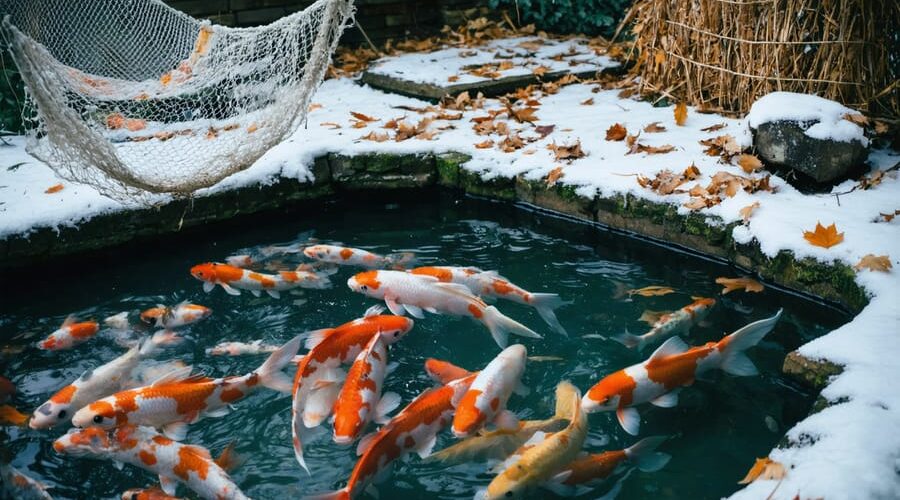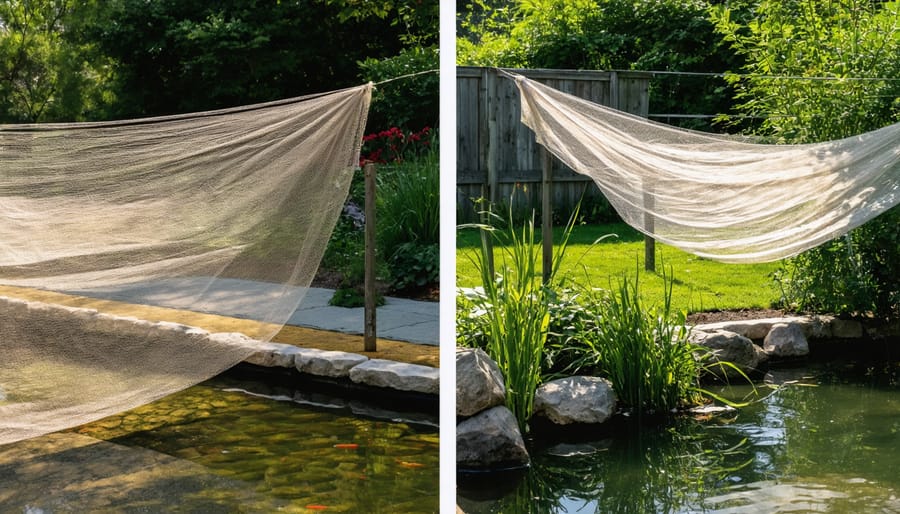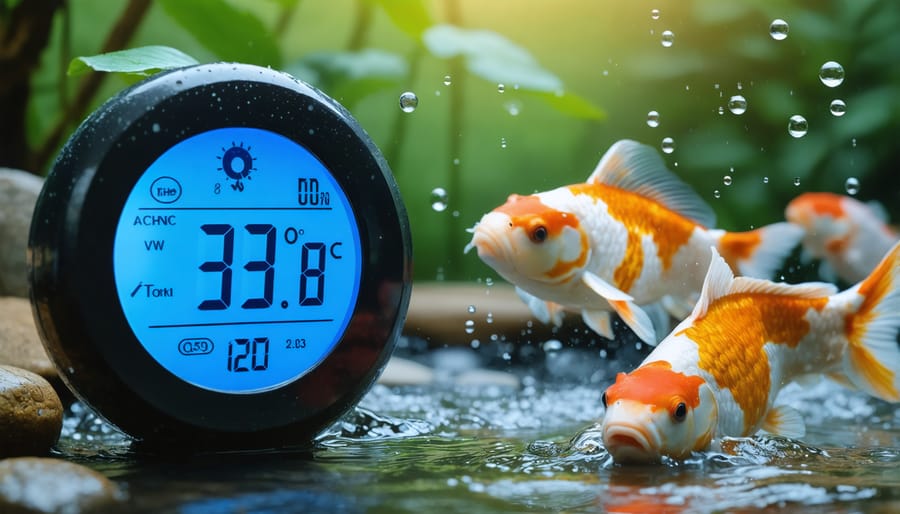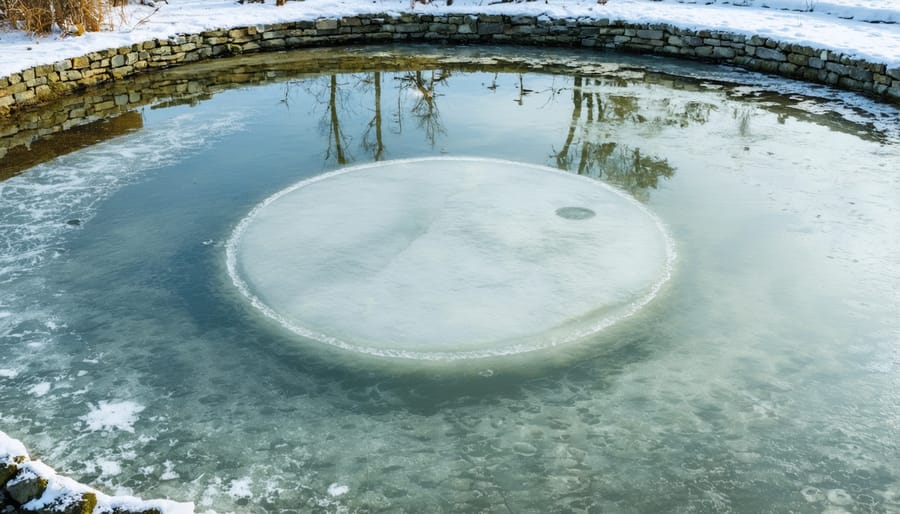
Keep Your Koi Safe and Healthy This Winter (A Pond Owner’s Survival Plan)
Protect your koi during winter by lowering their feed intake gradually as temperatures drop below 50°F, ultimately stopping when water reaches 40°F. Install a floating de-icer to maintain vital gas exchange and prevent ice formation across the pond’s surface. Deploy a cold-weather aerator at mid-depth to ensure adequate oxygen levels without disturbing the warmer bottom layer where koi naturally gather. Following these essential koi pond care practices helps your fish survive even the harshest winters while maintaining optimal water conditions. Remove fallen leaves before they sink and decay, as decomposing organic matter can deplete oxygen levels critical for winter survival. Monitor water quality weekly, paying special attention to ammonia levels, which can spike during periods of reduced biological filtration activity.
Preparing Your Koi Pond for Winter
Fall Cleaning and Maintenance
As temperatures begin to drop, proper winter pond maintenance starts with a thorough fall cleanup. Begin by skimming fallen leaves and debris from your pond’s surface using a fine net. Don’t forget to trim back dying aquatic plants and remove any dead foliage that could decay in the water.
Next, clean your pond’s filtration system thoroughly. Remove and rinse filter media, but avoid using tap water as it can kill beneficial bacteria. Instead, use pond water to preserve your biological filtration. Check all pumps and UV clarifiers for wear and tear, cleaning or replacing parts as needed.
Pay special attention to the bottom of your pond. Use a pond vacuum to remove accumulated sludge and debris, which can release harmful gases when decomposing under ice. If you have a bottom drain, ensure it’s clear and functioning properly.
Consider installing a pond net above the water surface to catch falling leaves. This simple step can save you hours of cleanup work and prevent organic matter from affecting water quality. Remove any string algae now, as it can become problematic under ice cover.
If you’re planning to use a winter pump or aerator, clean and test it thoroughly before the cold sets in. This equipment will be crucial for maintaining oxygen levels and keeping a hole in the ice during winter months.
Installing Winter Protection
As winter approaches, installing proper protection for your koi pond becomes crucial for the safety and well-being of your fish. Start by installing a sturdy pond net across the surface before autumn leaves begin to fall. This prevents debris from sinking and decomposing in your pond while also protecting your koi from predators.
For areas with harsh winters, consider investing in a pond cover or tent structure. These come in various styles, from simple floating covers to more elaborate greenhouse-like structures. When installing, ensure the cover is properly secured to withstand winter winds while leaving enough space above the water surface for gas exchange.
If you’re using a floating cover, add support poles or hoops to prevent it from sagging into the water when heavy with snow. Place small flotation devices or pool noodles under the cover to maintain an air pocket above the water surface.
Don’t forget to protect your pond’s edges with insulating materials like straw bales or bubble wrap. This helps prevent the pond from freezing solid at the margins. If you have waterfall features, consider installing ice prevention devices around them to maintain a small opening for gas exchange.
Remember to regularly check your protective measures throughout winter, removing any accumulated snow from covers and ensuring all components remain securely in place. This maintenance helps prevent sudden collapses or damage that could compromise your pond’s winter protection system.

Managing Water Temperature and Quality
Temperature Monitoring
Regular temperature monitoring is crucial for maintaining proper water temperature in your koi pond during winter. Invest in a reliable digital pond thermometer that can provide accurate readings – floating thermometers work well and are easy to read from the pond’s edge. Check the temperature at least once daily, preferably at the same time each day, to track any significant changes.
For optimal koi health, aim to keep the water temperature as stable as possible. Sudden temperature swings can stress your fish and compromise their immune systems. If you notice the temperature dropping below 50°F (10°C), it’s time to take action with your heating system or add extra insulation to prevent further cooling.
Keep a temperature log throughout the winter season. This simple practice helps you spot concerning patterns and adjust your pond management accordingly. Note any unusual fish behavior alongside temperature readings, as this can help you better understand how your koi respond to temperature changes.
Consider installing a pond temperature alarm system that alerts you when temperatures fall outside your set range. These devices can be particularly helpful during extreme weather events or if you’re away from home. They provide peace of mind and allow for quick response to potentially dangerous temperature drops.
Remember that different areas of your pond may have varying temperatures. Take readings at different depths and locations to ensure you’re getting an accurate picture of the overall pond environment. Pay special attention to areas where your koi tend to gather during winter months.

Water Quality Maintenance
Even though your koi are less active during winter, it’s crucial to maintain water quality to ensure their health and well-being. Regular testing becomes your best friend during these colder months, as water parameters can change quickly under ice coverage.
Keep a close eye on ammonia levels, which should stay below 0.25 ppm. Test your water weekly using a reliable test kit, checking for ammonia, nitrites, nitrates, and pH. The ideal pH range for winter should remain between 7.0 and 8.4. If you notice any concerning changes, adjust parameters gradually to avoid stressing your koi.
Winter presents unique challenges for water quality. Decomposing plant matter can release harmful compounds, so remove fallen leaves promptly. While bacterial activity slows down in cold water, your biological filtration should continue running to process any waste, albeit at a reduced rate.
Don’t forget about dissolved oxygen levels. Ice coverage can limit gas exchange, potentially creating dangerous conditions for your koi. Using an air pump or surface agitator helps maintain adequate oxygen levels without causing too much disturbance to your fish’s winter rest.
If you’re using a pond net to catch falling leaves, remember to clear it regularly. Heavy snow accumulation on nets can cause them to sag or break, potentially affecting water quality. Also, avoid breaking ice directly on the pond surface, as the shock waves can stress your koi. Instead, use a floating de-icer to maintain a small opening for gas exchange.
Feeding Your Koi in Winter
Winter Diet Adjustments
As temperatures drop, your koi’s metabolism slows significantly, requiring careful adjustments to their feeding routine. When water temperatures fall below 50°F (10°C), reduce feeding to once per day. Once temperatures dip below 45°F (7°C), switch to feeding every other day using a wheat germ-based food, which is easier for koi to digest in cold conditions.
Stop feeding completely when water temperatures reach 39°F (4°C) or below. Don’t worry – this is natural for koi, as they enter a semi-dormant state during winter. Their bodies can sustain themselves using stored fat reserves from summer feeding.
Choose high-quality, low-protein winter food specifically formulated for cold water conditions. These special winter foods contain the right balance of nutrients while being easier to digest in lower temperatures. When feeding, offer only what your fish can consume within 5 minutes to prevent excess food from decomposing in the pond.
Remember to remove any uneaten food promptly and store winter feed in an airtight container in a cool, dry place to maintain its nutritional value.
When to Stop Feeding
Knowing when to stop feeding your koi is crucial for their winter health. As water temperatures begin to drop, your fish’s metabolism slows down significantly. Start monitoring water temperature daily when autumn arrives. When the temperature consistently stays below 50°F (10°C), it’s time to stop feeding your koi completely.
During the transition period, while temperatures are between 50-60°F (10-15°C), gradually reduce feeding frequency and switch to wheat germ-based food, which is easier to digest in cooler temperatures. Pay attention to your fish’s behavior – they’ll naturally become less active and eat less as temperatures drop.
Don’t be tempted to feed your koi during brief warm spells in winter. Even if they appear hungry, their digestive systems aren’t equipped to process food properly in cold conditions. Feeding during this time can lead to serious health issues since undigested food can rot in their stomachs. Resume feeding only when spring arrives and water temperatures consistently stay above 50°F (10°C) for at least a week.
Operating Equipment in Freezing Conditions
Maintaining Air Flow
Maintaining proper oxygen levels in your koi pond during winter is crucial for your fish’s survival. While the cold water naturally holds more dissolved oxygen than warm water, the frozen surface can prevent essential gas exchange, potentially harming your koi.
A reliable air pump is your best friend during winter months. Position it to create gentle movement at the water’s surface, which helps prevent complete freezing while ensuring oxygen circulation. Place the air stone about 1-2 feet below the surface – deep enough to be effective but not so deep that it disturbs the warmer bottom layer where your koi rest.
Remember to protect your air pump from the elements by housing it in a weatherproof container or small shelter. This prevents moisture damage and ensures consistent operation throughout winter. Consider investing in a backup pump as insurance against equipment failure during critical cold periods.
For optimal results, use multiple smaller air stones rather than one large one. This creates better circulation throughout the pond and prevents “dead zones” where oxygen levels might drop. Position them strategically around the pond, focusing on areas where your koi tend to gather.
Don’t forget to check your air pump and lines regularly throughout winter. Ice can form in the airlines, blocking airflow, so inspect them weekly and carefully remove any ice buildup. If you notice reduced bubbling, check for blockages or kinks in the tubing.
A properly aerated winter pond will help your koi remain healthy until spring, while also preventing toxic gas buildup under the ice. Your fish will thank you for maintaining these crucial oxygen levels during their winter rest.
De-icer Management
A reliable de-icer is essential for maintaining a healthy koi pond during winter. These devices keep a small area of the pond surface free from ice, allowing toxic gases to escape and oxygen to enter. When choosing a de-icer, opt for a floating model with at least 1000 watts of power for most backyard ponds. Place it in the shallowest area of your pond, as this is where ice typically forms first.
Monitor your de-icer daily during freezing weather. Clear any ice buildup around the unit to maintain its effectiveness, and ensure it stays plugged in and functioning correctly. If you notice the de-icer struggling to keep an area open, consider adding a second unit or using an air pump in conjunction with it.
Never break ice on your pond surface manually, as this can create harmful shock waves that stress your koi. Instead, let your de-icer do its job. If you need to create an opening, place a hot pan on the surface to melt through gently.
Position your de-icer away from any underwater shelters where your koi might be resting. The constant movement and noise could disturb their winter torpor. Keep the power cord secured and protected from damage, and regularly check for any signs of wear or malfunction.
For added efficiency, consider using a thermostat controller with your de-icer. This helps conserve energy by operating the unit only when temperatures approach freezing, saving on electricity costs while maintaining safe conditions for your koi.

Caring for your koi pond during winter doesn’t have to be overwhelming. By following the essential steps we’ve discussed, you can ensure your precious koi remain healthy and thriving throughout the cold season. Remember to gradually prepare your pond as temperatures drop, maintain appropriate water depth, and keep a watchful eye on water quality parameters.
The key to successful winter care lies in being proactive rather than reactive. Installing a reliable de-icer, maintaining proper filtration, and adjusting feeding schedules according to water temperature will significantly improve your koi’s chances of emerging strong and healthy in spring. Don’t forget to regularly check for ice formation and maintain that crucial gas exchange opening in the surface.
Most importantly, trust your instincts and observations. Every pond is unique, and you’ll become more confident in managing yours with each passing season. Keep monitoring your koi’s behavior, as they’re excellent indicators of the pond’s overall health. If you notice anything unusual, don’t hesitate to act promptly.
With proper preparation and attention to detail, your koi can not only survive but thrive during the winter months. Come spring, you’ll be rewarded with vibrant, energetic fish ready to grace your pond with their beautiful colors and playful personalities. Remember, successful winter pond care is a journey, not a destination, and each season brings new learning opportunities.
